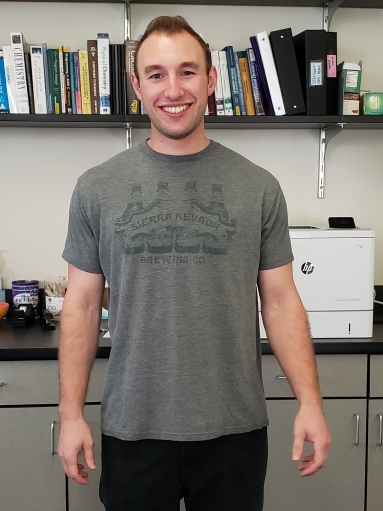
Logan Augustine, a 4th-year student in the Mason group, is the recipient of a prestigious Department of Energy Office of Science Graduate Student Research (SCGSR) award, and will spend a year at Los Alamos National Laboratory working on a computational project to separate neptunyl ions from nuclear waste in solution. Neptunyl, a linear molecule made up of a single neptunium atom and two oxygen atoms, is highly radioactive, but unlike uranium and plutonium has no well-developed means of separation from the soup of species found in nuclear waste. Neptunyl also reacts with itself in solution, yielding a mixture of +4, +5, and +6 species, which complicates extraction. Augustine's modeling project employs a strategy of attaching benzoate and bipyridine ligands, functionalized with electron-withdrawing and -donating groups, to the equatorial plane of the neptunyl ion, with an aim of binding them strongly enough to carry neptunyl from an aqueous to an organic phase. Should such separation techniques develop to the point of industrial use, they could allow neptunium recycling or transformation and re-use in producing nuclear energy, as well as reduction in the radioactivity of the remaining nuclear waste. He will be working with Dr. Ping Yang, Acting Deputy Director of the G.T. Seaborg Institute for Transactinium Science at LANL.
Augustine is also a co-investigator on a successful NSF XSEDE (Extreme Science and Engineering Discovery Environment) proposal for over 2.3 million hours of high-performance computing in the coming year. Part of graduate and postdoc student professional development in the Mason group is the chance to gain practice writing proposals. Prof. Sara Mason says that Logan "played a critical role in obtaining the timing information needed to justify our allocation request...and also helped craft the project description." As an investor in the University of Iowa's High Performance Computing systems, the Mason group has dedicated nodes on campus, but the new capacity allows group members to use NSF's supercomputers in San Diego and Pittsburgh as well. "It's nice to not have to fight other people in the group for running jobs," Augustine jokes.
Originally from Urbandale, Iowa, Augustine came to the Department of Chemistry from Lincoln Memorial University in Tennessee, where he had been recruited as a baseball player. LMU gave him his first exposure to computational research, working on bismuth germanate detector response functions in a reaction involving the gamma radiation produced after excitation of a fluorine nucleus. He came to Iowa intending to join the Mason group. Thinking about what appeals to him about computational chemistry, he says, "Even though computational chemistry has now been around for a while, being able to apply it to actinide systems like neptunium is just still so understudied, so being able to be still on that emerging edge of studying these new systems where there's just not a ton of studies on it yet...that's what probably draws me." The ability to describe highly radioactive systems computationally and guide experimentalists in their research design, potentially reducing their exposure to radiotoxicity, is also an important aspect of his chosen area of chemistry.